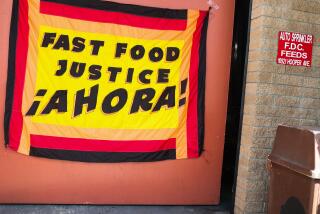Drive-Throughs: Have It Your Way
- Share via
Despite the obvious culinary merits and convenience of a double cheeseburger to go, drive-through windows are the latest targets of cities across Southern California in their efforts to fight smog, traffic and noise. Local officials claim that idling cars contribute to the region’s air quality problems. And neighbors of the restaurants complain that customers queuing for a quick bite clog surrounding residential streets. Once lovable icons of the San Fernando Valley’s car culture, drive-through windows are more and more often raising the hackles of planners and residents.
Some cities have imposed blanket restrictions as the easiest answer. But it’s the wrong one. Burbank, for instance, banned 24-hour drive-through windows. Sierra Madre forbade drive-through windows altogether. More commonly, though, new restaurants proposing a drive-through window are subjected to a grueling review process. For instance, developers of a Burger King on Ventura Boulevard in Encino fought a nasty battle with homeowners in 1993 before having a drive-through approved by the City Council.
In the 65 years since local zoning laws were upheld by the Supreme Court, cities and counties across the country have used their power properly to regulate the location of everything from factories to low-income housing. As times change, so do the imperatives of local land-use laws. What worked in the past may not be appropriate for the future. That is fast becoming the case in regard to drive-through windows. Some recognize Southern California’s dependence on the automobile as one of the largest contributors to the region’s most intractable problems. Others just don’t want drive-throughs near their homes--but want them everywhere else.
Fixing the situation fairly requires more sophistication than most local planning agencies can muster--and more attention than most restaurant companies are willing to give. Both sides need to pay more attention to the how of drive-through design and less to the where.
The $100-billion fast-food industry estimates that half its profits come from drive-through windows. Eliminating them outright would surely have a catastrophic effect on an industry that employs multitudes of low-skilled workers. At the same time, the thousands of fast-food outlets across Southern California dump millions of dollars in tax revenues into city and county coffers. Besides, studies commissioned by the food industry claim that cars produce more harmful emissions when they are parked and started than when they idle in line.
To be sure, an inappropriate drive-through window can harm the character of a neighborhood and can make bad intersections worse. That’s where careful planning comes in. Just as it’s counterproductive to allow a drive-through on some pedestrian-oriented areas of Ventura Boulevard, it’s unfair not to allow one on auto-oriented stretches of, say, Roscoe or Sepulveda boulevards. Special attention should be paid to such seemingly mundane, but critical, elements as how cars get in and out of the parking lot and how their turns might gum up traffic on surrounding streets. The Supreme Court 65 years ago compared inappropriate uses of land to pigs in the parlor. That still holds true today. Often, the drive-through itself is not the problem. The problem arises when it’s too close to the parlor.
More to Read
Sign up for Essential California
The most important California stories and recommendations in your inbox every morning.
You may occasionally receive promotional content from the Los Angeles Times.













